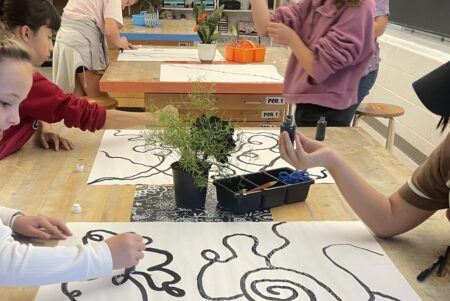Teaching with Contemporary Art
Can’t Funeral

Photo courtesy of Amber Arnold.
As Charlotte, one of my elementary art students, ran into the classroom, she shouted with a surprised squeal of glee, “There are plants growing!” Every time she came to art, the first thing Charlotte did was check on the flowers growing in the planter that held dirt and scraps of paper from our Can’t Funeral. She spent time speaking to them and would excitedly remind me that she was “giving the plants CO2” before heading to her seat.
Artmaking and learning are challenging—if they were easy, we wouldn’t be learning! During the first few rotations of each new school year in my K-5 art classroom, we held a “Can’t Funeral.” The Can’t Funeral allowed us to discuss and accept that we’re going to feel frustrated when we make mistakes, but those mistakes are opportunities to learn. As artists, we are able to problem solve and turn our mistakes into something new. Instead of saying, “I can’t do this,” we reframed our thinking and focused on the learning. We discussed how “I need help” or “I don’t know how to do this YET” were ways to express our frustration while still persevering. During our Can’t Funeral, students wrote the word “can’t” on small slips of paper. We then destroyed that negative attitude! Students were asked to crumple, stomp, rip, or cut up their can’t papers. Once destroyed, the negative attitudes were buried in real dirt in a large flower pot in our classroom. I surreptitiously planted flower seeds and, over time, the flowers began to grow. The plants grew into a visual reminder that artists problem solve and turn their mistakes into something new.

Photo courtesy of Amber Arnold.
With so many pressures on students in today’s world, there is often a desire from students for “the right answer” as well as an impatience for that answer to come quickly. However, neither learning nor making art are quick things with one right answer. As art educators, we all want our students to embrace a growth mindset, to think critically, problem solve, grapple with big ideas, and learn to take creative risks. We want to foster our students’ creativity and deepen their learning. We want them to embrace the process and learn from their mistakes. These life lessons learned in the art classroom go beyond the classroom walls. However, a growth mindset, life-long learning, and artmaking don’t happen automatically. They require intentionality from us, the educators.
This intentionality involves our classroom environment, curriculum, and the relationships we build. In the safety of an intentionally crafted creative space, students and teachers can learn alongside one another and engage in meaningful artmaking. A strong, positive classroom management system that includes rules, clear consequences, and routines for materials sets the tone and creates a predictable space. In my classroom, we were an art class team. Everything from the way the rules were worded to how we passed out supplies supported a collaborative effort and team mindset.

Production still from the Art in the Twenty-First Century Season 6 episode, “Change.” © Art21, Inc. 2012
Establishing the tone of your space from the very beginning is important. For the first two rotations of each school year, we focused on our art class team and how our team would operate. There was the crucial unpacking of the rules, the tour of the art room, creation of visual verbal journals, and assigning of the seats, all culminating with the Can’t Funeral. With the initial seeds for a positive tone for our classroom planted, we moved forward into the school year learning from artists who embody the philosophies of the Can’t Funeral. We explored perseverance through the work of Yayoi Kusama, taking creative risks through Allan McCollum’s installations, and letting go of perfection with El Anatsui’s changeable sculptures. These and other artists remind us to focus on the “yet.” It’s okay to be frustrated or find something difficult, because we all face obstacles. It’s okay to explore new ideas, because we can find creative solutions to overcome those obstacles. It’s okay if those ideas are unsuccessful, because we’re learning through the process.
Through the intentionality of the classroom environment, teaching curricula, and team mindset, in our classroom “can’t” almost became a taboo word. It represented the fixed mindsets we worked to reframe, and students would remind one another to avoid it. Each year, even if they had previously participated in the Can’t Funeral, they excitedly engaged in destroying their “can’ts,” pursuing their “yet,” and continuing their journey as an artist.



